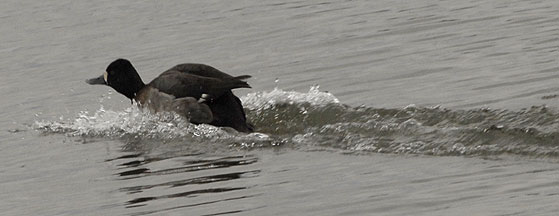
picture by J R Compton. http://www.JRCompton.com/photos/The_Birds/J/
Adaptations

image by JR Compton.http://www.JRCompton.com/photos/The_Birds/J/
The numerous adaptations that Lesser Scaup possess in order to successfully utilize their environmental surroundings on a daily basis are actually quite impressive. Because Aythya affinis is a diving duck, it possesses general adaptations that are common to all other species of ducks as well as a variety of very specialized adaptations that enable it to capture its food in this interesting manner.
Much like other ducks, the Lesser Scaup, due to the fact that it has wings rather than hands, compensates for this disparity with an exceptionally strong beak which it uses to obtain food. The beak also comes in very handy for separating matter such as seeds and plants that it wants to ingest for nutrition, from the water that is sucked up in the process. Another way in which Aythya affinis species are suited for their lifestyle is in the hollowed, lightweight bones that make up their skeleton. These allow them to fly with ease and use an aerial means of transportation when migrating from place to place. Also contributing to this cause are the strong muscles located in their chests, making long trips through the air possible.
 Because Lesser Scaup spend the majority of their time in water,
their feathers are coated with an oil that acts as a barrier
surrounding them to keep water out. The gland that this oil is
stored in is located on the duck's back towards the base of the upper
tail feathers. To utilize this function, Lesser Scaup reach back with their bill
and spread the oil out making sure to reach all
of their feathers. Because the feathers of this bird experience so
much wear and tear in the outdoors, Lesser Scaup make use of yet
another adaptation known as molting. This is the process by which
the bird loses all of its feathers and replaces them with a whole,
brand-new set.
Because Lesser Scaup spend the majority of their time in water,
their feathers are coated with an oil that acts as a barrier
surrounding them to keep water out. The gland that this oil is
stored in is located on the duck's back towards the base of the upper
tail feathers. To utilize this function, Lesser Scaup reach back with their bill
and spread the oil out making sure to reach all
of their feathers. Because the feathers of this bird experience so
much wear and tear in the outdoors, Lesser Scaup make use of yet
another adaptation known as molting. This is the process by which
the bird loses all of its feathers and replaces them with a whole,
brand-new set.
Now for the diving!
Lesser Scaup, as stated earlier, are a diving duck. This means that
in order to obtain their meals, they dive, submerging their entire
body under water. Lesser Scaup often dive to depths around 20 feet!
This process definitely requires some specialized adaptations.
For a start, ducks in general capture air within their feathers which assists them in floating on the water. So diving ducks, when preparing to go under in search of food, flatten their feathers, which in turn releases this air causing the buoyancy they experience to decrease. This allows for longer, and therefore more successful, dives.
Picture below by J R Compton.http://www.JRCompton.com/photos/The_Birds/J/
 Lesser Scaup also possess larger, webbed feet that they use to
generate lots of power when diving towards the depths. For the
same reason, their legs are located further back on their bodies
than in non-diving ducks. This quality, along with others that Scaup
have to increase diving efficiency such as more compact wings and
bodies, do have consequences in flying though. Because their bodies
are specially suited to dive via higher densities, they require much more
effort to reach aerial flight, usually involving much "running"
across the water before lift-off. Regardless, diving ducks like
Lesser Scaup are experts at what they do. In fact, newborn ducklings
are already able to go underwater for short periods of time on their
first day of life and by the time they reach 5-7 weeks old, they
have the capacity to stay submerged for 2-25 seconds swimming
anywhere from 15-18 meters at a time.
Lesser Scaup also possess larger, webbed feet that they use to
generate lots of power when diving towards the depths. For the
same reason, their legs are located further back on their bodies
than in non-diving ducks. This quality, along with others that Scaup
have to increase diving efficiency such as more compact wings and
bodies, do have consequences in flying though. Because their bodies
are specially suited to dive via higher densities, they require much more
effort to reach aerial flight, usually involving much "running"
across the water before lift-off. Regardless, diving ducks like
Lesser Scaup are experts at what they do. In fact, newborn ducklings
are already able to go underwater for short periods of time on their
first day of life and by the time they reach 5-7 weeks old, they
have the capacity to stay submerged for 2-25 seconds swimming
anywhere from 15-18 meters at a time.
Find out about more interesting species of diving ducks, the Common Merganser(Mergus merganser) and the Bufflehead(Bucephala albeola)!
Go to Nutrition and discover what Lesser Scaup feed on to give them the energy they need to use all of these adaptations.